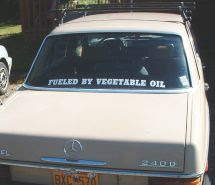 Biodiesel Homebrew Guide by Maria "Girl Mark" Alovert: everything you need to know to make quality alternative diesel fuel out of waste restaurant fryer oil.
Biodiesel Homebrew Guide by Maria "Girl Mark" Alovert: everything you need to know to make quality alternative diesel fuel out of waste restaurant fryer oil.This is the book that I used years ago to learn how to brew biodiesel and build my reactor. It's currently up to edition 10.5, revised in 2007. There's no fluff here, no personal stories or politics, just the information you need to make your own biodiesel.
Girl Mark is one of the best known and well respected activists in the homebrew biodiesel community. She is famous for traversing the country leading workshops for the masses. She is the inventor of the water-heater based weldless-fumeless Appleseed processor and is a DIY expert on many internet forums.
Her book was written as a companion to her classes and it reads in a very comfortable, conversational tone. After a quick overview of biodiesel versus other veg-fuels; she jumps right into what to expect when using biodiesel, the good and the bad - in a friendly, but honest way.
With an eye for keeping it cheap and accessible to DIY folks, she emphasizes alternatives to expensive scales and chemicals, while still being safe. Biodiesel Homebrew Guide then leads you through test batches, titration, dewatering techniques, brewing fuel and quality testing.
The coolest thing about this book is its focus on chemistry for non-chemists. Yes, there's a quick explanation of what's going on in your reaction, but where the Biodiesel Homebrew Guide really shines is explaining what the reaction should look like, what it shouldn't look like, and how to test and fix substandard reactions. She explains and describes emulsions - ways to break them, and ways NOT to break them. The book tells you which popular DIY tests work, which ones aren't worth doing - and explains WHY. The book even goes into detail about the little white clumps that occasionally show up, and the creamy middle layer that we sometimes see.
Biodiesel Homebrew guide covers water-washing options, goes into depth about the pros and cons of each technique, and gives recommendations about which mist nozzles work best. It also includes a really cool section on acidulating and purifying glycerol, as what comes out of the processor is only about 40% glycerine - in a cocktail of methanol, soap and catalyst.
Finally Girl Mark provides a number of plans for building a basic or a bell-and-whistles Appleseed processor and stand-pipe wash tank.
Like other homebrew books it does not go into methanol recovery or acid-base reactions, but it does point you in the right direction - if that's where you are headed.
Biodiesel Homebrew Guide is definitely a work in progress, perhaps more like a 'zine than a book. It came as a stapled together pile of photocopies and contains a number of spelling and grammatical errors. There are also a few places where it seems that some paragraphs had been updated, but others referred to older editions of the book.
It's not a slick shiny book, but it is the DEFINITIVE guide for the thrifty do-it-yourself crowd. If you want to understand what's going on in your processor, and how to make quality fuel, then this is the book for you.
It's the perfect complement to b100supply's Home Brew Biodiesel - which has clearer plans and recipes, but doesn't go into as much depth about what you're seeing happen during the reaction.
You can buy Biodiesel Homebrew Guide for $18 (including shipping to Alaska) directly from Girl Mark at localb100.com/book.html
Veg On!


